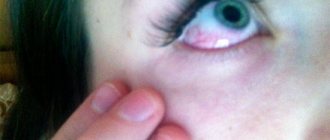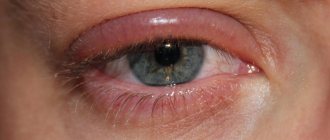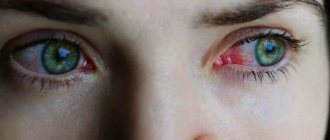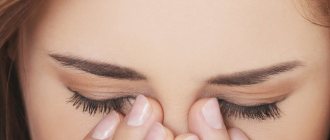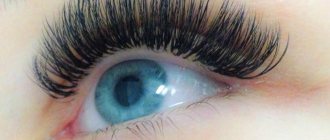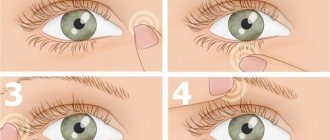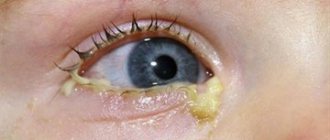Red eyes after sleep are an important signal by which the body lets you know about illness, overwork or stress that has affected the organ of vision. In some cases, professional help is required, especially when it comes to inflammatory diseases of the anterior segment and appendages of the eyeball. In other (less complicated) situations, you can remove the redness of the whites of the eyes yourself. It all depends on the conditions and factors that led to the expression of the unpleasant symptom. The causes of red eyes after sleep, their correct recognition and methods of elimination will be discussed further.
Conjunctivitis.
If red eyes in the morning are accompanied by other symptoms - purulent or clear discharge, lacrimation, photophobia, discomfort, this may indicate infectious conjunctivitis. This disease is contagious and is transmitted by contact, so if you have conjunctivitis, you need to maintain hygiene and, if possible, avoid contact with other people until complete recovery. Only a doctor should prescribe treatment after diagnosing the nature of conjunctivitis - bacterial or viral.
Causes of red eyes after sleep
Hyperemia after sleep may indicate harmless conditions or diseases. The sclera contains blood vessels, which, under the influence of various factors, expand and burst due to oversaturation with blood.
The main reason for this condition is overwork. With prolonged stress, small capillaries expand. They become filled with blood and may burst or remain in this state. If fatigue is severe, even after sleep they remain dilated.
The second reason is crying before going to bed. Intracranial pressure increases, the eyes are not only red, but also swollen. There are no other signs. Therefore, you should not be surprised that hyperemia appeared in the morning. Sleep disturbance is another harmless cause of red eyes after. Adequate sleep should be at least 8 hours a day.
If sleep is constantly interrupted, the eyes do not fully rest, the blood vessels dilate, so every morning a person sees reddened whites in the mirror.
Other harmless reasons:
- Incorrect use of contact optics. Lenses should be cleaned daily, refilled with new disinfectant solution, and not worn at night unless they are intended for this purpose. If hygiene rules are not followed, the eyes will not only turn red, but irritation and inflammation of the mucous membrane will appear.
- Weather. Bright light, snow, strong wind and dry air lead to the appearance of this symptom. The symptom may not go away for several days.
- Getting mascara, eye shadow or other cosmetics into your eyes.
- Cosmetics on the eyes. Before going to bed, you should always remove makeup from your eyes. It causes irritation, and, as a result, the eyes are red after sleep.
The cause of hyperemia may be a pathological condition. It can have serious consequences and requires urgent therapeutic measures.
Pathological causes include:
- blepharitis;
- conjunctivitis;
- uveitis;
- chronic dry eye syndrome;
- abuse of eye drops;
- Sjögren's syndrome.
Sleeping at night with contact lenses
Hyperemia can be caused by non-compliance with wearing contact optics. If you sleep in lenses designed for daytime wear, your eyes will almost certainly turn red the next morning. The reason for this is insufficient oxygen supply. The problem can be easily solved by choosing lenses with extended or continuous wear. Examples of such models are Air Optix Night&Day from Alcon or PureVision from Bausch + Lomb. These optical products have high oxygen permeability and allow the eyes to “breathe” freely even at night.
MagazinLinz.ru team
What diseases have similar symptoms?
The reasons discussed above are quite innocent, and to cope with redness, be attentive to how your lifestyle affects your eye health. But illness can also be the cause, and in this case you should consult a doctor.
Conjunctivitis
This is an inflammatory infectious disease that affects the conjunctiva of the eyes. It can often be caught from dirt that gets into the eyes; Constant contact with a sick person, neglect of personal hygiene, or the disease may be a consequence of allergies increase the risk. There are several forms and types of conjunctivitis, each requiring special treatment.
Episcleritis
Episcleritis is inflammation of the outer layer of the sclera. This may be indicated by redness of the fibrous membrane, swelling of the eyelids, tearing and headaches.
Uveitis
Uveitis is a designation for various diseases that lead to redness of the choroid and inflammation of the eyelids. Occurs due to infection, mechanical injuries, burns, allergies, diabetes, menopause in women, etc.
Blepharitis
Blepharitis is a group of diseases, the main symptom of which is redness in the eyelid area and inflammation. The patient is bothered by itching, burning and periodic pain. This disease may be the result of allergies or decreased immunity.
And these are not all the diseases that can threaten your eyes.
Treatment
Treatment methods can vary: from the use of eye drops, ointments, gels to eye training and a radical overhaul of lifestyle.
Medicines
Before using medications to treat redness of the eyes, consult with a specialist what to use, in what doses, with what frequency and where is the best place to buy it. Many remedies have contraindications - by self-medicating, you can only worsen the problem!
Drops
One of the most common ways to combat redness is with eye drops. There are several types, and the use of each depends on the cause of the disease, so do not think that drops are a recipe for all problems.
- Anti-inflammatory drops eliminate swelling and can help with eye injuries, allergies, infections and autoimmune diseases. Available for sale: Diclofenac, Garazon, Benoxy, Maxitron, Tobradex.
- Antibacterials are prescribed against bacterial infections. They can prescribe Floxal, Cipropharm, Oftalmodek, Sulfatsil.
- Vasoconstrictors restore microcirculation of the eyeball, constrict blood vessels during hyperemia, help with conjunctivitis: Visin, Montevisin, Octilia, Okumetil.
- Antiviral drops are prescribed if there is a risk of infection by groups of viral pathogens: Poludan, Oftalmoferon, Aktipol.
If you wear lenses, you can use Natural Tear, Inox or Systain Ultra.
For young children and infants, Oxial and Oftolik are prescribed.
Gels
There are several gels for eye treatment:
- Actovegin - can help with mechanical damage to the eye or burns. Improves tissue metabolism and restores eyes at the cellular level.
- Blefarogel - used to prevent inflammation and redness of the eyes, itching and other irritations. Regulates metabolism in tissues and fights swelling.
- Solcoserine is a drug used to treat conjunctiva, inflammation and regeneration of the cornea.
- Oftagel - used to prevent dry eyes, helps restore the protective film.
Ointments
Eye ointments can be of several types:
- Hormonal ointments - prescribed for viral infections or allergic complications. They are among the most effective, but have a large list of contraindications. These are Tobrex, Hydrocortisone, Dexamethasone.
- Antibacterial ointments - fight bacteria, destroy them from the inside and stop reproduction. They have a moisturizing and healing effect - Tetracycline, Floxal.
- Antiviral ointments - prescribed for viral infection. Can be dispensed without a doctor's prescription - Acyclovir.
- Healing ointments - prescribed after burns or mechanical injuries to the eyes. They accelerate cell regeneration, have a healing effect and relieve pain - Actovegin, Korneregel.
- Moisturizing ointments - prescribed for dry eye syndrome. Relieves symptoms of the disease and moisturizes the surface - Oftagel.
Folk remedies
Traditional methods are a double-edged sword. They can indeed cope with some symptoms or at least alleviate the course of the disease, but in no case should they replace the treatment prescribed by a doctor.
The advice here is the same - consult with a specialist and do not rely solely on the “grandmother’s” method. And don’t treat children this way: their eyes are still developing, and they may have visual impairments.
Folk remedies that can be used:
- The easiest way, probably known to everyone, is to apply an ordinary cold spoon to tired, inflamed eyelids.
- Cut the cucumber into slices and apply to the eyelids, hold for 10 minutes. This method helps remove redness and inflammation.
- If you like to drink tea, don't throw away your used tea bags. They can be applied to the eyelids for 10 minutes in the morning. Green tea is a good remedy for inflammation and redness; you can try putting it in your eyes.
- Take a raw potato, carrot or apple, cut it on a grater, wrap it in gauze and apply it for 5 minutes. Helps fight hyperemia.
- Mix oak bark, linden bark and chamomile in equal amounts, add a glass of water and cook over low heat for 10 minutes. Place the finished broth in a cool, dark place, keep for an hour and filter through cheesecloth. Fill the molds with it and freeze it in the freezer. We wipe our eyelids with the resulting ice flakes in the morning, or you can apply it to your eyes, first wrapped in a scarf.
- Try a contrast shower to relieve general fatigue.
Prevention
In order not to waste your time on doctors, not to philosophize with folk remedies and generally maintain the health of your eyes, follow simple rules in everyday life:
- Follow the rules of hygiene: wash your hands regularly before eating, do not rub your eyes with dirty hands, especially outside the home, wash your face, remove makeup before going to bed, and use only high-quality cosmetics and washing supplies.
- Change towels and bed linen more often.
- Eat right - fresh greens, fish, nuts, bananas and liver in your diet will help strengthen your immune system.
- Give up bad habits - first of all, stop smoking, drinking and being nocturnal.
- Rest as often as possible and do not overload yourself with computers and gadgets.
- Establish a daily routine: get up, eat and go to bed at the same time.
- If spending a long time at the computer or reading is unavoidable, take breaks from working (5-10 minutes every hour).
- If you wear glasses, consider purchasing a pair of specially coated lenses.
- Ventilate the work area, do wet cleaning more often, and do not sit in the dark or in poor lighting.
- Do not neglect glasses in windy and dry weather.
- If you work in production, be sure to use eye protection as prescribed by safety regulations.
- Consult an ophthalmologist about what drops can be used for prevention.
Diagnostics
A trip to the hospital is mandatory if you wake up for several days in a row with bloodshot eyes, if your vision has decreased significantly, if you feel nauseated, dizzy and react strongly to light, but do not understand the reason.
At your doctor's office, be sure to report any symptoms you notice. The specialist will ask a couple of questions about your lifestyle, the presence of chronic and viral diseases. Next will be:
- external examination of the eye;
- fundus ophthalmoscopy using special instruments;
- if the cause is infection, then microbiological examination will be required
- measure blood or intravenous pressure;
- In addition, they may send you to a dentist, neurologist, surgeon, or prescribe blood, urine, and eye discharge tests.
What drugs can be used
Today, pharmacies offer a wide range of different moisturizing drops in different price ranges from domestic or foreign manufacturers. You need to look for drugs from the “Artificial tear” series. The most famous, well-advertised eye drops in this category are Visine. But it doesn't end there. As alternative remedies, you can try Oxial, Licontin, Innox.
The listed drugs do not have a whitening effect. But due to the fact that they quickly and effectively moisturize the mucous membrane, the irritation goes away, and along with it the redness goes away. To enhance and consolidate the effect, ophthalmologists recommend taking an additional course of vitamin A or Ascorutin tablets. These drugs strengthen blood vessels and reduce the risk of rupture.
Chamomile tea in the morning after a sleepless night is recommended both internally and as a lotion for red eyes
You can also use folk remedies. As a rule, these are a variety of compresses and lotions. For eye fatigue, swelling and redness after a feast or a long cry, ice cubes or simply tampons soaked in cold water will help. Cooling compresses relieve itching and burning from conjunctivitis. But for blepharitis, on the contrary, compresses or lotions soaked in a warm herbal decoction should be applied to the eyes several times a day. The following medicinal plants are suitable:
- chamomile;
- calendula;
- series;
- sage.
If you don’t have any medicinal herbs on hand, you can apply warm bags of black or green tea to your eyes, but only without aromatic additives. Both cold and hot compresses should be kept on the eyes for at least ten, but no more than twenty minutes.
Note: in reality, there are many more folk remedies for eye redness if it is not caused by an ophthalmological disease. Many women keep spoons in the freezer and apply them to their eyes after a fun party to remove redness and swelling. For others, mugs of fresh cucumber help. And some people use grated raw potato gruel.
In what cases is it necessary to consult a doctor?
If you wake up and notice that your eyes are red, this is not a reason to immediately run to the clinic. The culprit may be ordinary overwork, it will go away, you just need to try to relax and do a couple of exercises. But if the redness does not go away for more than three days in a row, then this is a sure sign that something is wrong with your health and you need to contact an ophthalmologist.
Observe the sensations. Run to a specialist if:
- something is constantly in the way in the eye;
- visual acuity dropped sharply;
- tears flow naturally;
- eyes fester;
- in the morning there are yellow crusts on the eyelashes;
- feel a headache and feel dizzy;
- Bright light hurts my eyes.
We don’t want to scare you, these symptoms can be the cause of a serious illness, which, if not treated in time, in the worst case, you can lose your vision.
What to do?
Below are the main methods of dealing with eye redness after a night's rest.
Removing redness with exercises
When your eyes are red in the morning, you can quickly bring them back to normal with special gymnastics. They spend it after a day of work, or for a child after school. They include exercises for moving the gaze from one object to another, circular rotation of the eyes, and frequent blinking.
After exercise, give your eyes a rest by placing tea bags or cucumber slices on your eyelids. At night, remove lenses and remove cosmetics from eyelashes and eyelids to prevent redness of the sclera.
Drops, lotions for eye health
You can restore a healthy appearance to your eyes by instilling Visin, Vitabact, Oxial. For dry vision, use artificial tear drops. During spring and autumn, pay attention to taking vitamin A.
It is necessary to put medicines into the eyes correctly
Among homeopathic remedies, belladonna preparations are recommended. They fight redness and inflammation. Lotions made from aloe extract relieve inflammation in blepharitis, conjunctivitis, and keratitis. Lotions with:
- infusion of blue cornflower;
- Kalanchoe juice;
- fresh red clover juice;
- crushed plantain seeds soaked in water.
No ads 3
You can quickly relieve tension and redness in the eyes with ice packs, applying them for 5–10 minutes.
Physiotherapy
Hemorrhages on the sclera are treated with electrophoresis. Calcium chloride and potassium iodide are used from solutions. Thanks to the action of electric current and drugs, stagnation is eliminated. But the procedure cannot be used in patients with hypertension or severe vascular atherosclerosis. Devices with a low-frequency magnetic field eliminate the symptoms of blepharitis and keratitis.
Devices with laser radiation accelerate blood flow and eliminate eye inflammation. Infrared rays are used in the treatment of vision problems in children and adolescents. Ultraviolet irradiation is prescribed for redness of the eyes caused by inflammatory processes and allergies.

